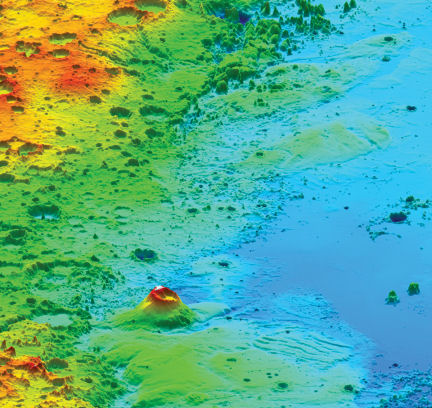Chilled Out? Ice could lurk beneath Martian equator
Radar observations from a craft orbiting Mars hint that an immense volume of ice-rich material may underlie a vast region along the Red Planet’s equator.

The long, narrow, and disconnected swaths of the Medusae Fossae formation extend about 5,400 kilometers along Mars’ equator, about a quarter of the way around the planet. This undulating landscape occupies the boundary between the cratered highlands of the planet’s southern hemisphere and the lowland plains of the north, says Thomas R. Watters, a planetary scientist at the Smithsonian Institution in Washington, D.C.
Much of the formation’s terrain is covered with wind-sculpted hills called yardangs, a sign that the exposed material erodes easily, says Watters. While some scientists have proposed that the Medusae Fossae sediments are composed of volcanic ash, others have suggested that they are ancient accumulations of windblown dust. In any case, Watters says, many researchers have supposed that the overall shape of the terrain follows that of the underlying bedrock.
Radar data collected by the European Space Agency’s Mars Express orbiter between March 2006 and April 2007 indicate otherwise, however. Some of the radar waves penetrated surface sediments and bounced back to reveal the underlying bedrock, says Watters. It turns out that the sediments of the Medusae Fossae formation, which in some places reach depths of more than 2 km, sit atop a flat, featureless surface that’s probably a continuation of the volcanic plains to the north.
The delay between radar echoes from the surface and from the bedrock provides clues about the properties of the formation’s material as well as its thickness, Watters and his colleagues report online and in an upcoming Science. Their analyses suggest either that the material is as much as 85 percent ice or that it is ice-poor and has an unexpectedly low density.
If low-density material made up the thickest sections of sediment, its lowermost layers would become compressed, says Watters, and the radar data show no sign of that happening.
The Medusae Fossae formation probably contains about 1.6 million cubic kilometers of material, similar to the volume of the layered deposits in the ice cap around Mar’s southern pole, says Watters.
Observations from other Mars-orbiting instruments have hinted at the presence of water elsewhere on the planet, but not in the Medusae Fossae formation (SN: 6/8/02, p. 355). However, the hydrogen-detecting sensors used for those observations could detect water only if it appeared within 1 meter or so of the surface, says William V. Boynton, a geochemist at the University of Arizona in Tucson.
Current models of Martian climate suggest that buried ice can’t persist in equatorial regions, says Jim Bell, a planetary scientist at Cornell University. “Scientists likely will be naturally and reasonably skeptical of the new findings,” he notes, but adds that “if the new results are correct, they’re unexpected and exciting; there’s nothing that says Mars can’t be perverse.”







